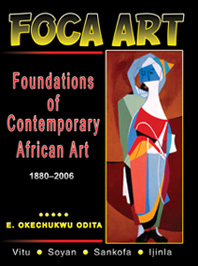Foundations of Contemporary African (FOCA) Art primarily deals with the stylistic classification and analysis of vision in art. To firmly root contemporary African art in African culture, this book begins with the examination of
persistent facts on African ancestral legacy and the enduring realities in
contemporary African art.
It arrives at three basic conclusions: firstly, that change in art comes from acculturation and that the process has frequently been perceived as operative in two directions—interchange in giver and receiver roles; secondly, that to make anything different from what it is, three questions must be addressed:
a) what would it become if left alone?;
b) what will would it become during change?; and
c) what would it become after the change?;
and thirdly, that the implications of all of the above bear heavily on the present state of contemporary African art.
It arrives at three basic conclusions: firstly, that change in art comes from acculturation and that the process has frequently been perceived as operative in two directions—interchange in giver and receiver roles; secondly, that to make anything different from what it is, three questions must be addressed:
a) what would it become if left alone?;
b) what will would it become during change?; and
c) what would it become after the change?;
and thirdly, that the implications of all of the above bear heavily on the present state of contemporary African art.
FOCA Art also identifies four major art styles :
1) Vitu art; 2) Soyan art;
3) Sankofa art; and 4) Ijinla art
1) Vitu art; 2) Soyan art;
3) Sankofa art; and 4) Ijinla art
These major art styles have also some sub-styles. Emphasis on this study was on art, styles, and artists, which led to uncovering of four basic principles:
1) that the quality of art defines the rank of the artist;
2) the quality of art explains the artist's experience;
3) the quality of art blurs the separation between the trained and self-trained artists; and
4) the quality of art distinguishes the artist's style.
For these reasons, Foundations of Contemporary African Art combines the theory and practice of art, using the preceding approach to produce a whole new study.
1) that the quality of art defines the rank of the artist;
2) the quality of art explains the artist's experience;
3) the quality of art blurs the separation between the trained and self-trained artists; and
4) the quality of art distinguishes the artist's style.
For these reasons, Foundations of Contemporary African Art combines the theory and practice of art, using the preceding approach to produce a whole new study.

